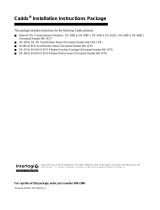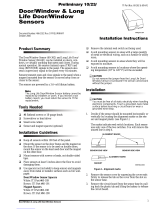Page is loading ...

8 3 9 4 g 0 9 b . d s f
1
/HDUQ0RGH6KRFN
6HQVRU
ITI Part No. 60-886-95
60-886-11-95
Installation Instructions
Product Summary
The Learn Mode Shock Sensor has the following three main
functions:
❑ To detect the vibrations made by an intruder trying to
break a window or door.
❑ To detect a window or door opening.
❑ To detect tamper situations, such as an intruder remov-
ing the sensor cover.
Vibrations cause a momentary open circuit in the shock ele-
ment of the sensor. The circuit closes again when the vibra-
tion stops. The sensor microcontroller “sees” the open/close
action as a pulse, causing the sensor to transmit an alarm
signal. The sensor has two different detection modes:
❑ Gross Attack - detect a violent blow sufficient in length
to trip sensor.
❑ Pulse Count - detect a sufficient number of less violent
blows (rapping or tapping).
The sensor includes an internal magnetic reed switch that
must be disabled if it is not used.
A cover tamper provides additional security if an intruder
tries to disable or damage the sensor.
Figure 1. Shock Sensor Main Components
Installation Guidelines
❑ Learn the sensor before adjusting the shock sensitivity.
The sensor is shipped with the reed switch enabled and
open, and this is how it must be learned.
❑ Before permanently mounting the sensor, test it at the
intended location to make sure that the panel can
receive sensor signal transmissions. The sensor is an
RF device and there may be blind or non-operational
locations within the installation. Normally, these can be
overcome by moving the sensor or receiver.
❑ Always mount the shock sensor so that the detector is
on the frame and not on glass, solid, or hollow-core
doors. See Figure 2 for mounting locations.
Figure 2. Mounting Options for Door/Window Styles
❑ Mount the sensor in a location where the structure can
transmit vibrations to the sensor.
❑ The sensor can be mounted on a vertical surface or on a
horizontal (flat) surface.
❑ Make sure the window fits snugly in the frame and
doesn’t move or rattle.
❑ Hold the sensor against the frame to make sure the sen-
sor base fits on the surface area of the frame and
doesn’t extend over the surface edges.
Shock Sensor Orientation
There are two types of shock sensor mounting orientations;
on a vertical surface or on a horizontal surface (sill or
ledge).
On a vertical surface, there are two orientations (see Figure
3).
Note
On a vertical surface, the shock sensor element must
always be oriented with its screw terminals down
, or the
writing on the shock element horizontal.
1 2 3 4 5 6
O N
Reed
Switch
Cover
Tamper
Switch
Battery
Holder
Shock
Element
DIP
Switches
LOGO
8 3 9 4 g 1 0 b . d s f
Shock Sensor
Shock Sensor Shock Sensor
Shock Sensor
Document Number: 466-1925 Rev. A
December 2001

2
Installation
Figure 3. Positioning shock element according to
mounting orientation on a vertical surface
On a horizontal surface (sill or ledge), any orientation is
allowed, but certain sensor element orientations are better
than others. The element is much better at detecting hori-
zontal vibrations perpendicular to its writing than parallel
(see Figure 4).
Figure 4. Positioning shock elements for horizontal
surface mounting
Tools and Supplies
❑ Control panel installation instructions
❑ Phillips screwdriver
❑ Slotted screwdriver (to pry off the cover)
❑ Two #6 x 3/4” flathead screws for mounting the sensor
(included)
❑ Two #6 x 5/8” screws for mounting the magnet
(included)
Installation
Caution!
You must be free of all static electricity when handling
electronic components. Touch a grounded, bare metal
surface before touching a circuit board or wear a grounded
wrist strap.
1. Insert a slotted screwdriver into the slot at the top end of
the unit and remove the cover (see Figure 5).
Figure 5. Remove the sensor cover
2. Using the flathead mounting screws, secure the base to
the mounting surface either vertically or horizontally as
required (see Figure 6).
Figure 6. Sensor base mounting holes
3. Position the shock element and press it firmly into its
socket (see Figure 7).
4. If using the reed switch, use the two remaining screws
to mount the magnet so that its arrow is aligned with the
arrow on the sensor case (see Figure 7).
Figure 7. Magnet alignment
Important! You must disable the reed switch if you
are not using it. If the reed switch is enabled but no
magnet is installed, the sensor will be in a continuous
alarm state.
1 2 3 4 5 6
O N
1 2 3 4 5 6
O N
Shock
Element
Shock
Element
Screw
Terminals
Screw
Terminals
LOGO
LOGO
1 2 3 4 5 6
O N
1 2 3 4 5 6
O N
Shock
Element
Shock
Element
Screw Terminals
Screw
Terminals
Parallel
Perpendicular
(Bad)
(Good)
LOGO
LOGO
Direction of
Vibration
8 3 9 4 g 0 2 b . d s f
Top
End
Slot
1 2 3 4 5 6
O N
Shock
Element
Mounting
Hole
Mounting
Hole
(Located
Under Shock
Element)
LOGO
Magnet
Arrows

3
Reed Switch Setting
Adjusting the Shock Sensor
DIP Switches
The following describes the DIP switch functions:
❑ DIP Switches 1 and 2—adjust the Pulse Count.
❑ DIP Switches 3 and 4—adjust the sensitivity setting of
Gross Attack detection.
❑ DIP Switch 5—enable/disable reed switch.
❑ DIP Switch 6—not used.
Note
In order for the LED to indicate shock detection while
adjusting the sensitivity, be sure the reed switch is dis-
abled (DIP switch 5 OFF) or that the magnet is lined up
with the reed switch if DIP switch 5 is ON.
Gross Attack Adjustment
1. To adjust the sensor for Gross Attack, set DIP switches
1 and 2 to the ON position. This disables the Pulse
Count so that the unit can only be activated by a Gross
Attack.
2. Apply high level shocks to the mounting structure, using
the LED as a guide to when the alarm trips (LED on for
4 seconds).
The LED will blink for 1 second every time the sensor
detects a pulse. A shock that is severe enough to cause
an alarm will cause the LED to light for approximately 4
seconds.
3. Use switches 3 and 4 to adjust the Gross Attack sensitiv-
ity of the sensor (see Table 1).
4. Repeat step 2 each time you make a sensitivity change.
Pulse Count Adjustment
1. Set the sensor to the desired Pulse Count (see Table 2).
Note
Pulse Count signals are counted at 1-second intervals
and stored in a 30-second digital memory. These small
signals can detect an intruder gently prying open a win-
dow or door frame.
2. To test the pulse count setting, generate small shocks on
the mounting structure. Each time a shock is detected, a
pulse is registered in memory and the LED will blink for
one second. If the programmed pulse count is reached
within the most recent 30 seconds, the alarm will trip
and the LED will light for approximately 4 seconds. If
the alarm trips for any reason, the stored pulses are can-
celled.
3. Use switches 1 and 2 to adjust the Pulse Count.
4. Repeat step 2 each time you make a sensitivity change.
Reed Switch Setting
After adjusting the sensor sensitivity, set DIP switch 5 to the
appropriate setting, ON for enabled or OFF for disabled.
System Programming
This section describes the basic steps for adding the sensor
to panel memory. Refer to the specific panel installation
instructions for complete programming details.
The reed switch must be enabled and open when learning
the sensor.
1. With the cover on the sensor, set the panel to Program
mode.
2. Proceed to the Learn Sensors menu.
3. Select the appropriate sensor group and sensor number
assignments.
4. When prompted by the panel to trip the sensor, remove
the sensor cover to activate the tamper switch.
5. Exit program mode.
RF Testing
This section describes the basic steps for testing the sensor.
Refer to the specific panel or receiver installation instruc-
tions for complete testing details.
1. Set the panel to Sensor Test.
2. Trip the sensor.
3. Listen for appropriate response from system sirens.
4. Exit Sensor Test.
Battery Replacement
When the system indicates that the sensor has a low battery,
remove the old battery and install a new battery (Duracell
DL123A or a Sanyo CR123A) into the battery holder,
observing proper polarity.
Caution!
Replace only with a Duracell DL123A battery or a Sanyo
CR123A battery. Observe polarity when installing a new
battery. Installing the battery backwards may cause
damage to the sensor.
Dispose of used batteries according to the manufacturer’s
instructions and/or local government authorities.
Table 1: Gross Attack Sensitivity Settings
DIP Switch 3 DIP Switch 4 Sensitivity
OFF OFF 1 (maximum sensitivity)
ON OFF 2
OFF ON 3
ON ON 4 (minimum sensitivity)
Table 2: Pulse Count Adjustment
DIP Switch 1 DIP Switch 2 Pulse Count
OFF OFF 4
ON OFF 6
OFF ON 8
ON ON Disabled

4
Specifications
Specifications
Compatibility................ All ITI 319.5 MHz Learn Mode
Panels/Receivers
Case dimensions........... 1.4 inches (3.5 cm) W x 6.0 inches
(15.2 cm) L x 1.25 inches
(3.2 cm) H
Operating temperature.. 32° to 122° F (0° to 50° C)
Storage temperature...... -29° to 140° F (-34° to 60° C)
Humidity....................... 90% relative humidity
non-condensing
Battery .......................... Duracell DL123A or Sanyo
CR123A 3V Lithium (ITI part
number 34-030)
Transmitter frequency... 319.5 MHz
Transmitter Range ........ 500 feet open air
FCC Notices
This device complies with FCC Rules Part 15. Operation is subject to the
following two conditions:
1. This device may not cause harmful interference.
2. This device must accept any interference that may be received,
including interference that may cause undesired operation.
Changes or modifications not expressly approved by Interlogix, Inc. can
void the user’s authority to operate the equipment.
FCC ID: B4Z-802A-SHOCK
2266 Second Street North | North Saint Paul Mn | 55109 | 800-777-2624 | www.itii.com | www.interlogixsecurity.com
©2001 Interlogix,™ Inc. Interlogix is a trademark of Interlogix, Inc. ITI is a registered trademark of Interlogix, Inc.
/

